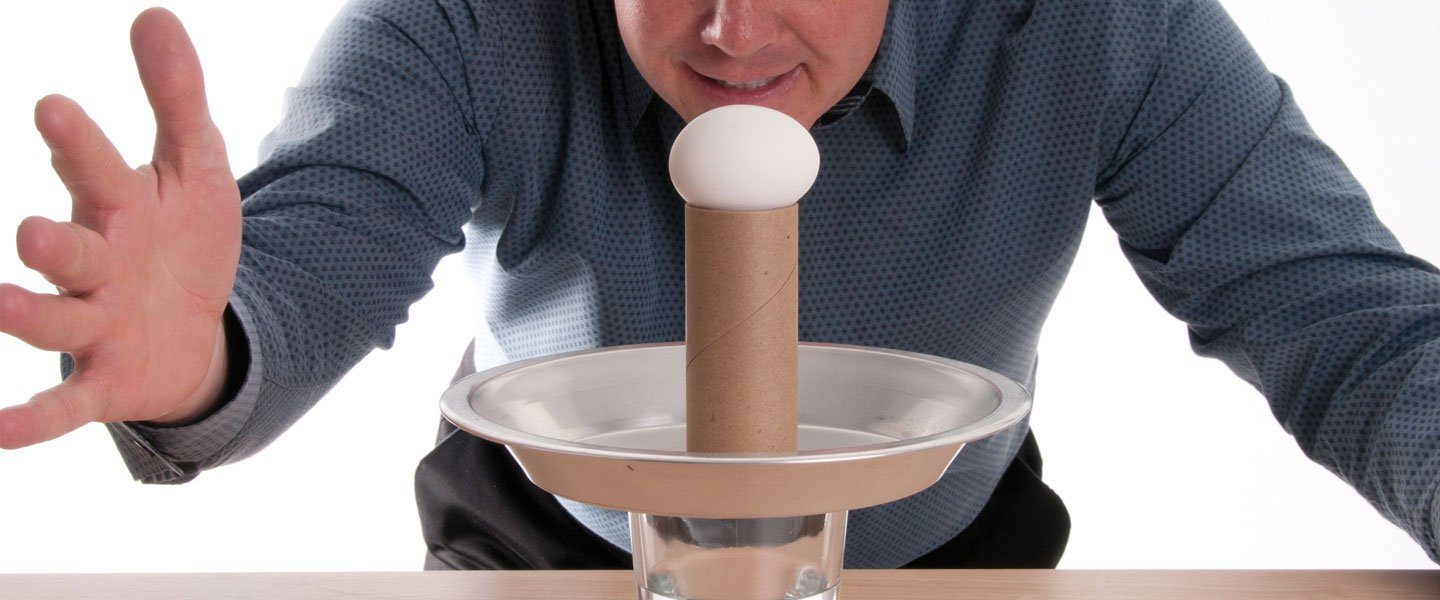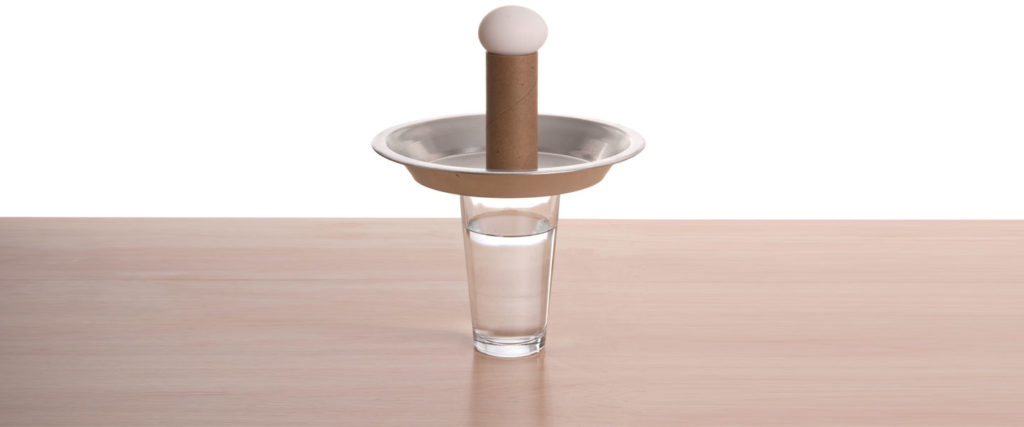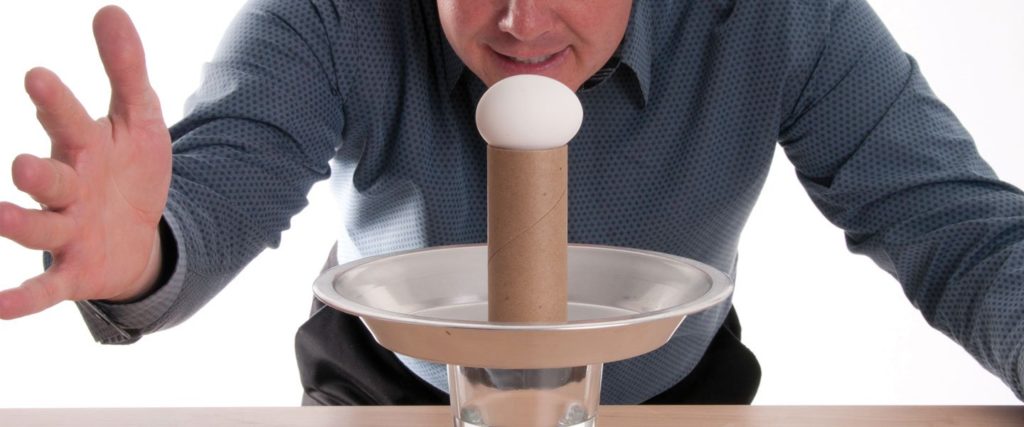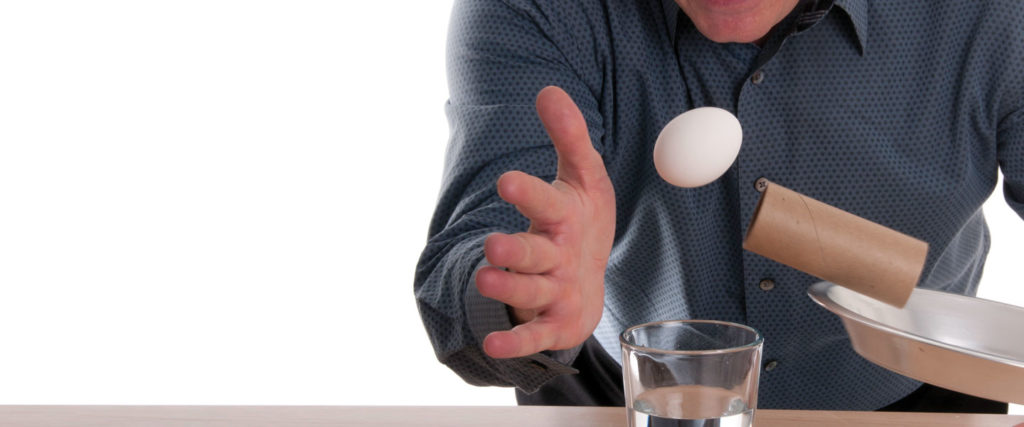Inertia Ring
The object of this activity is to get the hex nut to drop into the plastic bottle. Simple enough but there will be something in the […]

The egg drop is one of my all-time favorite science demonstrations. It’s a combination of strategy, skill, and just a little luck. The goal is to get an egg to drop into a glass of water. Sound easy enough? Did I mention that the egg is perched high above the water on a cardboard tube and that a pie pan sits between the tube and the water? Still think it’s easy? Sir Isaac Newton does. Once you try it, you’ll be hooked!

Pick a sturdy table or counter surface to perform the demonstration. Fill the drinking glass about three-quarters full with water and center the pie pan on top of the glass. Place the cardboard tube vertically on the pie pan, positioning it directly over the water. Carefully set the egg on top of the cardboard tube.

Explain to your audience that the goal is to get the egg into the glass of water, but you’re not allowed to touch the egg, the cardboard tube or the glass of water. The only thing left for you to touch is the pie pan. What would you need to do to move the pie pan and cardboard tube out of the way in order for the egg to fall into the glass of water? That’s right . . . you’re going to invoke Sir Isaac Newton’s First Law of Motion and smack the pie pan out of the way. Don’t do it just yet . . . read the next step.

Stand directly behind the Egg Drop setup. If you’re right handed, hold your right hand straight out like you were going to karate chop something. Position your hand about 6 inches away from the edge of the pan. The idea is to hit the edge of the pie pan with enough force to knock the cardboard tube out from under the egg. Gravity will do the rest as the egg falls directly into the glass of water.
Shoot both hands up high over your head in celebration of your latest science miracle.
Credit for this one has to go to Sir Isaac Newton and his First Law of Motion. Newton said that objects in motion want to keep moving and objects that are stationary want to stay still—unless an outside force acts on them. So, since the egg is not moving while it sits on top of the tube, that’s what it wants to do—not move. You applied enough force to the pie pan to cause it to zip out from under the cardboard tube (there’s not much friction between the surface of the pan and the water container). The edge of the pie pan hooked the bottom of the tube, which then sailed off with the pan. Basically, you knocked the support out from under the egg. For a brief nanosecond or so, the egg didn’t move because it was already stationary (not moving). But then, as usual, the force of gravity took over and pulled the egg straight down toward the center of the Earth.
Also, according to Mr. Newton’s First Law, once the egg began moving, it didn’t want to stop. The container of water interrupted the egg’s fall, providing a safe place for the egg to stop moving so you could recover it unbroken. The force of gravity on the egg caused the water to splash out, and the audience burst into spontaneous applause.
Try testing longer cardboard tubes from a roll of paper towel, different size glasses or different size eggs. Do small eggs work as well as jumbo eggs?
The true Egg Drop connoisseur will never be content with a single egg falling into a single glass. The temptation is just too great to push the envelope and find a way to position two eggs, side by side, and attempt a drop. When it works (and it will), you’ll discover that two eggs just aren’t enough. After searching day and night for weeks on end (or maybe you’ll just find one lying around the house), you’ll find the perfect tray to hold three cardboard tubes and three eggs. It’s no longer a science experiment . . . it’s an obsession with the law of inertia and gravity. Wake the kids, phone the neighbors—this is going to be something special.
WARNING! IMPORTANT SAFETY RULES
Always wash your hands well with soap and water after handling raw eggs. Some raw eggs contain salmonella bacteria that can make you really sick!